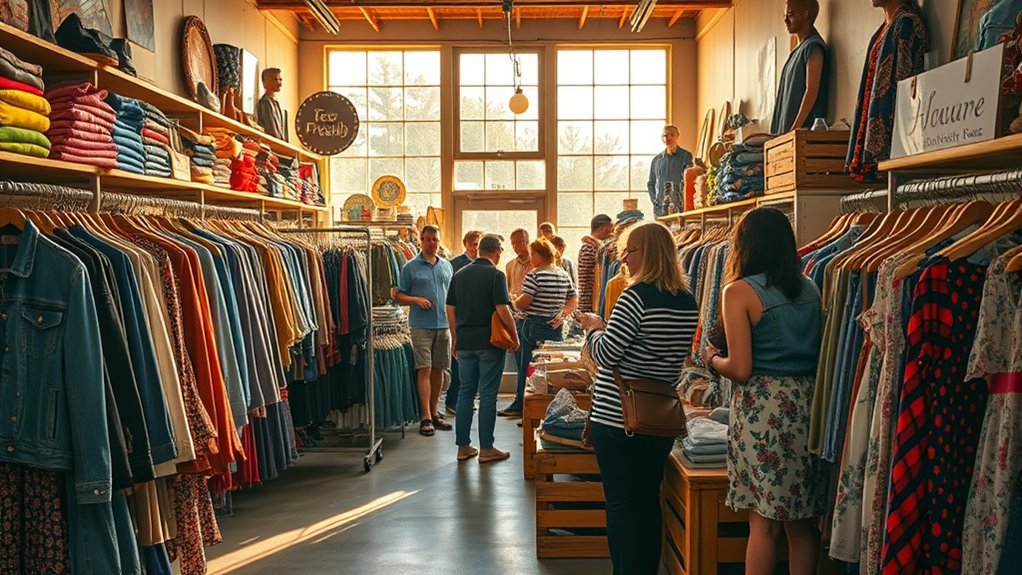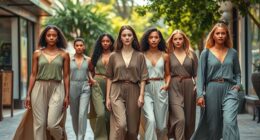In 2025, secondhand fashion skyrocketed because you increasingly seek sustainable, affordable, and unique styles. Online platforms and curated vintage collections make thrifting easier and more accessible than ever. This shift supports eco-friendly choices, reduces waste, and helps you stand out with one-of-a-kind pieces. The vintage revival and innovative shopping options are transforming fashion into a more responsible and personalized experience. Keep exploring to uncover how this movement continues to grow and impact your style.
Key Takeaways
- Growing consumer awareness of sustainability drove increased demand for eco-friendly secondhand fashion options.
- Online platforms and curated apps made browsing and purchasing vintage and thrift items more accessible and convenient.
- The vintage revival emphasized unique, high-quality pieces, attracting individuals seeking personalized style.
- Collaboration between brands and resale platforms expanded options, lowering prices and encouraging frequent thrifting.
- Secondhand shopping became a cultural movement, reflecting values of responsible consumption and individual expression.

The secondhand fashion market is experiencing explosive growth as more consumers seek sustainable and affordable alternatives to fast fashion. You’re probably noticing more people browsing thrift stores, online consignment platforms, and vintage shops than ever before. This surge isn’t just a trend; it’s a movement driven by a desire to make more conscious shopping choices. Sustainable shopping has become a core value, pushing many to look beyond new items and embrace pre-loved pieces that are both stylish and eco-friendly. By choosing secondhand, you’re reducing textile waste, cutting down on pollution, and extending the lifecycle of clothing, making a real impact on the environment.
Secondhand shopping is booming as more people embrace sustainable, stylish, and eco-friendly fashion choices.
The vintage revival plays a significant role in this shift. Classic styles, unique finds, and one-of-a-kind pieces appeal to your desire for individuality and authenticity. When you shop secondhand, you’re not just buying clothes—you’re reconnecting with fashion history. Vintage clothing carries a story, and wearing it gives you a sense of identity that mass-produced fast fashion can’t match. Plus, vintage items tend to be higher quality and more durable, giving you pieces that last longer. This revival also feeds into the thrill of the hunt—finding rare, well-preserved treasures that make your wardrobe stand out. The appeal of vintage isn’t just about nostalgia; it’s about making thoughtful, sustainable choices that reflect your personality.
You’re likely discovering that thrifting isn’t just practical; it’s exciting. The online secondhand market makes browsing easier than ever, with apps and websites offering a vast array of curated vintage collections. You can find everything from designer labels to retro finds, often at a fraction of their original price. This affordability encourages more frequent and intentional shopping, allowing you to experiment with different styles without breaking the bank. As secondhand fashion explodes in popularity, more brands are collaborating with thrift platforms or launching their own resale programs, further fueling the movement. It’s no longer just about saving money; it’s about making a statement and aligning your wardrobe with your values.
Ultimately, your involvement in secondhand shopping supports a more sustainable, creative, and personalized fashion landscape. The vintage revival demonstrates that fashion can be both eco-conscious and expressive, giving you a way to stand out while doing good. As the secondhand market continues to grow, you’re empowered to make smarter choices—reducing waste, embracing individuality, and contributing to a more sustainable future, one thrifted piece at a time.
Frequently Asked Questions
How Has Secondhand Fashion Impacted Traditional Retail Stores?
You’ve probably noticed that secondhand fashion has shaken up retail competition, making it tougher for traditional stores to attract shoppers. Customers now value sustainability and unique finds, which can reduce their loyalty to conventional brands. As a result, retail stores must innovate, offering more eco-friendly options or exclusive experiences, to keep pace and maintain their customer base amidst the growing popularity of secondhand fashion.
What Are the Environmental Benefits of Thrifting?
Imagine you’re helping reduce landfill waste by choosing thrifted clothes. Thrifting promotes sustainable practices by extending the life of garments, which considerably cuts down waste. For example, a mall-based thrift store in 2024 diverted tons of textiles from landfills. Your choice to buy secondhand supports waste reduction and encourages eco-friendly habits, making a real environmental impact with every purchase.
How Do Online Platforms Influence Secondhand Fashion Trends?
Online platforms shape secondhand fashion trends by creating virtual closets where you can showcase and discover styles effortlessly. Influencer marketing plays a big role, as popular figures promote thrifted finds, inspiring you to try new looks. These platforms make secondhand shopping more accessible and social, encouraging you to participate in trends and build a unique wardrobe. They turn thrifting into a fun, engaging experience that influences your fashion choices daily.
Are There Any Risks Associated With Buying Secondhand Clothing?
Imagine buying a vintage designer jacket online, only to find out it’s a fake. That’s a risk with secondhand clothing—you might face quality concerns or struggle with authenticity verification. Always check reviews, ask for detailed photos, and buy from trusted platforms. Being cautious helps you avoid counterfeit items and guarantees your purchase is genuine, so you can enjoy secondhand fashion without worry.
How Does Secondhand Fashion Affect Designer Brands’ Pricing?
You might wonder how secondhand fashion impacts designer brands’ pricing. When more people buy secondhand, it can lower brand valuation, especially if vintage or rare items become more accessible. This shift forces brands to adjust their pricing strategies to maintain exclusivity and profit margins. As a result, designers may raise prices on new collections or create limited editions to preserve their luxury status and control market influence.
Conclusion
As you dive deeper into the world of secondhand fashion, one thing’s clear—you’re part of something bigger. The movement’s just getting started, and the possibilities are endless. Will you embrace the trend and make a difference? Or watch from the sidelines as this revolution reshapes your wardrobe—and the planet? The choice is yours. But one thing’s certain: what comes next could change everything you thought you knew about fashion forever. Are you ready?









